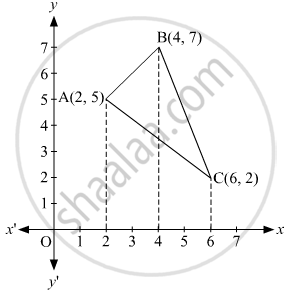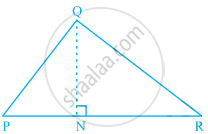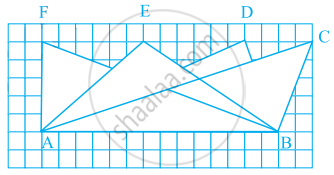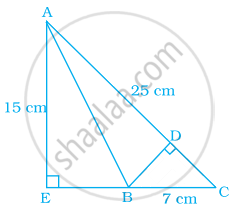Advertisements
Advertisements
Question
Using integration, find the area of triangle ABC, whose vertices are A(2, 5), B(4, 7) and C(6, 2).
Solution

Vertices of the given triangle are A(2,5), B(4,7), and C(6,2).
Equation of AB
`y - 5 = (7-5)/(4-2) (x -2)`
⇒ `y - 5 = x -2`
⇒ `y = x + 3`
Let's say y1= x+3
Equation of BC:
`y -7= (2-7)/(6-4)(x-4)`
⇒ `y = (-5)/(2) (x-4) +7=(-5)/(2) x+17`
Let's say `y_2 = -(5)/(2)x+17`
Equation of AC:
`y -5 = (2-5)/(6-2) (x-2)`
⇒ `y = (-3)/(4)(x-2)+5 = (-3)/(4)x+13/2`
Let's say `y_3 = (-3)/(4)x+13/2`
`"ar" (Δ"ABC") = int_2^4 y_1 dx + int_4^6 y_2 dx - int_2^6 y_3 dx`
= `int_2^4 (x+3) dx + int_4^6 ((-5)/2 x+17) dx -int_2^6 (-3)/4 x+13/2)dx`
= `[x^2/2 + 3x]_2^4 + [(-5x^2)/4 + 17x]_4^6 - [(-3x^2)/8 + (13x)/2]_2^6`
= `[16/2 + 12 - 4/2 -6]+[(-180)/4 + 102+80/4-68]-[(-108)/8+78/2+12/8-26/2]`
= 12 + 9 - 14
= 7 sq units.
APPEARS IN
RELATED QUESTIONS
The perimeter of a right triangle is 60 cm. Its hypotenuse is 25 cm. Find the area of the triangle.
Find the area of the triangle ABC with A(1, −4) and mid-points of sides through A being (2, −1) and (0, −1).
Find the area of the triangle formed by joining the mid-point of the sides of the triangle whose vertices are (0, –1), (2, 1) and (0, 3). Find the ratio of area of the triangle formed to the area of the given triangle.
For what value of k are the points (k, 2 – 2k), (–k + 1, 2k) and (–4 – k, 6 – 2k) are collinear ?
Find the area of the triangle whose vertices are: (2, 3), (-1, 0), (2, -4)
Determine the ratio in which the line 2x + y – 4 = 0 divides the line segment joining the points A(2, – 2) and B(3, 7).
If area of triangle is 35 square units with vertices (2, −6), (5, 4), and (k, 4), then k is ______.
Find the area of a triangle whose vertices are
(a, c + a), (a, c) and (−a, c − a)
The four vertices of a quadrilateral are (1, 2), (−5, 6), (7, −4) and (k, −2) taken in order. If the area of the quadrilateral is zero, find the value of k.
The vertices of ΔABC are (−2, 1), (5, 4) and (2, −3) respectively. Find the area of the triangle and the length of the altitude through A.
The point A divides the join of P (−5, 1) and Q(3, 5) in the ratio k:1. Find the two values of k for which the area of ΔABC where B is (1, 5) and C(7, −2) is equal to 2 units.
If `a≠ b ≠ c`, prove that the points (a, a2), (b, b2), (c, c2) can never be collinear.
Find the angle subtended at the origin by the line segment whose end points are (0, 100) and (10, 0).
Show that the points (-3, -3),(3,3) and C (-3 `sqrt(3) , 3 sqrt(3))` are the vertices of an equilateral triangle.
Show that the points A (3,1) , B (0,-2) , C(1,1) and D (4,4) are the vertices of parallelogram ABCD.
Find the area of ΔABC whose vertices are:
A(-5,7) , B (-4,-5) and C (4,5)
If the points P(-3, 9), Q(a, b) and R(4, -5) are collinear and a+b=1, find the value of a and b.
Find the area of ΔABC with vertices A(0, -1), B(2,1) and C(0, 3). Also, find the area of the triangle formed by joining the midpoints of its sides. Show that the ratio of the areas of two triangles is 4:1.
Find the value of x for which the points (x, −1), (2, 1) and (4, 5) are collinear ?
The points (0, 5), (0, –9) and (3, 6) are collinear.
If the points A(1, 2), O(0, 0) and C(a, b) are collinear, then ______.
Find the value of m if the points (5, 1), (–2, –3) and (8, 2m) are collinear.
The area of ∆ABC is 8 cm2 in which AB = AC = 4 cm and ∠A = 90º.
Area of triangle PQR is 100 cm2 as shown in the below figure. If altitude QT is 10 cm, then its base PR is ______.

Area of a right-angled triangle is 30 cm2. If its smallest side is 5 cm, then its hypotenuse is ______.
Observe all the four triangles FAB, EAB, DAB and CAB as shown in the given figure.

- All triangles have the same base and the same altitude.
- All triangles are congruent.
- All triangles are equal in area.
- All triangles may not have the same perimeter.
In the given figure, triangle AEC is right-angled at E, B is a point on EC, BD is the altitude of triangle ABC, AC = 25 cm, BC = 7 cm and AE = 15 cm. Find the area of triangle ABC and the length of DB.

Find the missing value:
| Base | Height | Area of Triangle |
| 22 cm | ______ | 170.5 cm2 |
